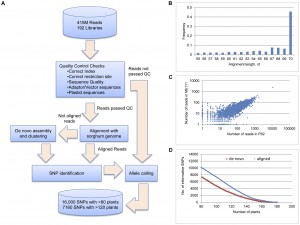The first comprehensive genetic mapping of miscanthus has been completed. Researchers have been studying the feedstock as a possible source for bioenergy. The goal of the project is to accelerate product development. The results were published in the online journal PLoS One and the project is a collaboration between Ceres and the Institute of Biological, Environmental and Rural Sciences (IBERS) at Aberystwyth University in Wales.
 The project entailed creating a collection of genetically related plants and then sequencing and analyzing DNA. Researchers mapped all 19 chromosomes of mischanthus and over several years have analyzed more than 400 million DNA sequences. The benefit of this research is that by isolating positive genes, for example a marker that would yield more biomass per plant, researchers can then focus on that gene, along with others, to create bioenergy superior feedstocks.
The project entailed creating a collection of genetically related plants and then sequencing and analyzing DNA. Researchers mapped all 19 chromosomes of mischanthus and over several years have analyzed more than 400 million DNA sequences. The benefit of this research is that by isolating positive genes, for example a marker that would yield more biomass per plant, researchers can then focus on that gene, along with others, to create bioenergy superior feedstocks.
Today, miscanthus is primarily grown in Europe and used for electricity generation. It is not commercially viable as a bioenergy feedstock due to high production costs and few miscanthus producers. Ceres Chief Scientific Officer Richard Flavell, PhD, FRS, CBE said that the company will be able to more rapidly introduce important crop traits. The company is currently evaluating various varieties in several locations and anticipates that its varieties of miscanthus will require less time, effort and money to be bred for different environments.
In the past the majority of miscanthus research focused on field trials and this is the first large-scale project of its kind to focus on its genetics. Iain Donnison, PhD and head of the bioenergy team at IBERS added that, “The joint miscanthus development programme with Ceres has provided new insight into the evolution of the species as well as the similarities and differences in populations across different countries and environments.”

